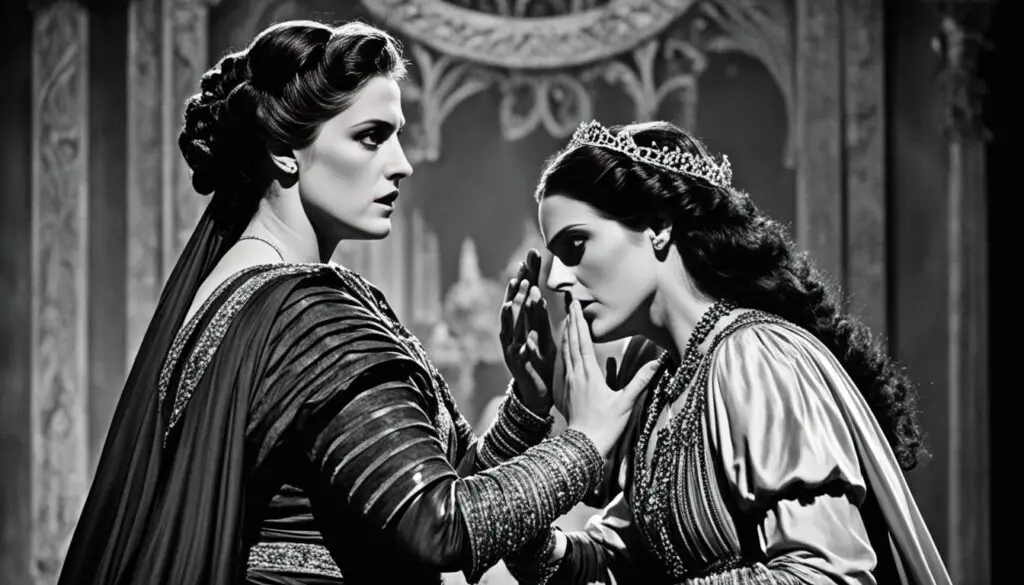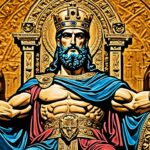Herodias is a significant figure in the Bible, mentioned in the New Testament in the stories of John the Baptist’s fate and her relationship with Herod Antipas and Salome. Herodias is portrayed as the wife of Herod Antipas, who was the ruler of Galilee. She is known for her role in the beheading of John the Baptist, as she was displeased with his criticism of her marriage to Herod Antipas.
Herodias cleverly orchestrates the execution by using her daughter Salome’s dance at a birthday dinner to gain a favor from Herod, who promises her anything she desires, up to half of his kingdom. Salome asks for the head of John the Baptist on a platter, and Herod, though regretful, fulfills the request to uphold his oath. The story of Herodias highlights themes of power, manipulation, and the consequences of rash decisions.
Key Takeaways:
- Herodias is a significant figure in the Bible.
- She is portrayed as the wife of Herod Antipas.
- Herodias plays a role in the beheading of John the Baptist.
- She uses her daughter Salome’s dance to manipulate Herod into executing John.
- The story highlights themes of power, manipulation, and the consequences of rash decisions.
Herodias and John the Baptist
Herodias’s most significant interaction in the Bible is with John the Baptist. John openly criticized her marriage to Herod Antipas, calling it unlawful according to Mosaic law. Herodias was displeased with John’s critique, as it threatened her power and the power of her new husband. Although Herod respected John and feared the repercussions of executing him, Herodias devised a plan to have him killed.
She used her daughter Salome’s dance at a birthday celebration to manipulate Herod into granting her a favor. Salome asked for the head of John the Baptist, and Herod, bound by his oath, reluctantly fulfilled the request. This encounter showcases the clash between Herodias’s desire for power and John’s commitment to truth and righteousness.
Throughout the Bible, Herodias and John the Baptist’s story portrays the tension between personal desires and adherence to moral principles. While Herodias’s actions underscore her thirst for power and control, John stands as a symbol of unwavering dedication to truth, even at the cost of his life.
Herodias and Salome
In the story of Herodias, her daughter Salome plays a crucial role. Salome danced at a birthday dinner for Herod, captivating him and his guests.
It is important to note that the dance itself is not explicitly described as seductive or sexually charged in the biblical text, contrary to popular depictions. Scholars suggest that Salome was likely a young girl, around ten or eleven years old, and her dance may have had a more theatrical or gymnastic nature.
Herod was so pleased with her performance that he promised her anything she desired, up to half of his kingdom. Salome consulted her mother, Herodias, who instructed her to request the head of John the Baptist. Salome relayed the request to Herod, leading to John’s execution.
The inclusion of Salome in the story highlights the manipulation and power dynamics within Herodias’s family.

“Salome danced at length to the delight of Herod and his guests, and the king declared with an oath: ‘Ask me for whatever you wish, and I will grant it to you, up to half of my kingdom.’”
This episode showcases Salome’s ability to influence Herod through her dance, and how Herodias manipulates this moment to achieve her own agenda. By appealing to Herod’s desire for entertainment and pleasing his guests, Salome sets the stage for her mother’s plan to execute John the Baptist.
The story of Herodias and Salome demonstrates the complex interplay of power, manipulation, and familial relationships in biblical narratives.
Herod Antipas and Herodias
Herodias’s story in the Bible is closely intertwined with her marriage to Herod Antipas, the ruler of Galilee. This union, however, was far from conventional and became a controversial topic within biblical narratives.
To fully understand the significance of Herodias’s marriage to Herod Antipas, it is crucial to recognize that she was already married to Herod’s brother, Philip, at the time. This intermarriage caused outrage and criticism, particularly from John the Baptist, who cited Mosaic law to deem it unlawful.
“It is not lawful for you to have your brother’s wife.” – Mark 6:18
In spite of the criticism, Herod Antipas respected John and feared the consequences of executing him. However, Herodias harbored a deep desire for John’s death and skillfully manipulated her husband into granting her request through a strategic plan involving her daughter, Salome.
“Ask me for whatever you wish, and I will give it to you.” – Mark 6:23
Salome’s dance at a birthday celebration mesmerized Herod and his guests. Herod, pleased with her performance, made an oath to grant her anything she desired, up to half of his kingdom. It was at this opportune moment that Salome sought her mother’s counsel and requested the head of John the Baptist.
| Relationship | Description |
|---|---|
| Herod Antipas | Ruler of Galilee, married Herodias despite her being the wife of his brother, Philip. Respected John the Baptist and revered his teachings. Feared the consequences of executing John. |
| Herodias | Married to Herod Antipas, previously married to Philip, Herod’s brother. Desired John the Baptist’s death and skillfully manipulated her husband through her daughter’s dance. |
The marriage between Herod Antipas and Herodias represents a complex intersection of power, relationships, and the clash between personal desires and societal norms. It portrays the struggles faced by individuals in positions of authority, torn between their obligations and their personal ambitions.

Key Takeaways
- Herod Antipas’s marriage to Herodias was controversial and drew criticism from John the Baptist.
- Herod Antipas respected John and feared the consequences of executing him, but Herodias desired John’s death.
- Through manipulation and her daughter Salome’s dance, Herodias secured the fulfillment of her request.
- The marriage between Herod Antipas and Herodias represents a clash between personal desires and societal norms.
Herodias in the New Testament
Herodias is mentioned in the New Testament in relation to the stories of John the Baptist’s fate and her involvement with Herod Antipas and Salome. Herodias’s presence in the biblical narrative serves as a cautionary tale, shedding light on the consequences of abusive power and manipulative behavior.
The clash between Herodias’s desire for personal gain and John the Baptist’s unwavering commitment to truth and righteousness is a central theme in these accounts. It underscores the stark contrast between their values and the moral implications of their actions.
The inclusion of Herodias in the New Testament also offers insights into the complexities of marriage, family dynamics, and societal expectations during biblical times. Herodias’s story prompts reflection on the societal roles and expectations placed on women within that cultural and historical context.
By examining the biblical references to Herodias, we gain a deeper understanding of the dynamics of power and the moral complexities that arise in biblical narratives. It serves as a reminder of the timeless relevance and universal themes found throughout the Bible.

Key takeaways:
- Herodias’s presence in the New Testament highlights themes of power, manipulation, and the consequences of rash decisions.
- The clash between her desire for personal gain and John the Baptist’s commitment to truth and righteousness is a central focus in these narratives.
- These biblical references shed light on the complexities of marriage, family dynamics, and societal expectations during the biblical era.
- Herodias’s story serves as a cautionary tale and prompts reflection on the dynamics of power and the moral choices individuals make.
Conclusion
The story of Herodias in the Bible delves into the intricate dynamics of power, manipulation, and the far-reaching consequences of impulsive decisions. Herodias, a woman of immense influence, played a pivotal role in the beheading of John the Baptist, revealing the clash between personal desires and societal norms. Utilizing her position, Herodias cunningly orchestrated the execution with calculated precision, epitomizing the extent someone would go to fulfill their desires.
The inclusion of Herodias’s daughter, Salome, further underscores the manipulative nature of Herodias’s actions. Together, they exemplify the intricacies of power dynamics and the moral choices individuals make when driven by their ambitions. The story encourages us to reflect on the role of women, the influence they wield, and the moral implications that arise in their pursuit of personal gain.
By exploring the narrative of Herodias in the Bible, we gain valuable insights into the multifaceted nature of biblical stories and their enduring themes. The tale prompts us to contemplate the complexities of relationships, the weight of societal expectations, and the consequences of our actions. Through Herodias, we are reminded of the timeless relevance and thought-provoking lessons that can be drawn from biblical narratives.







